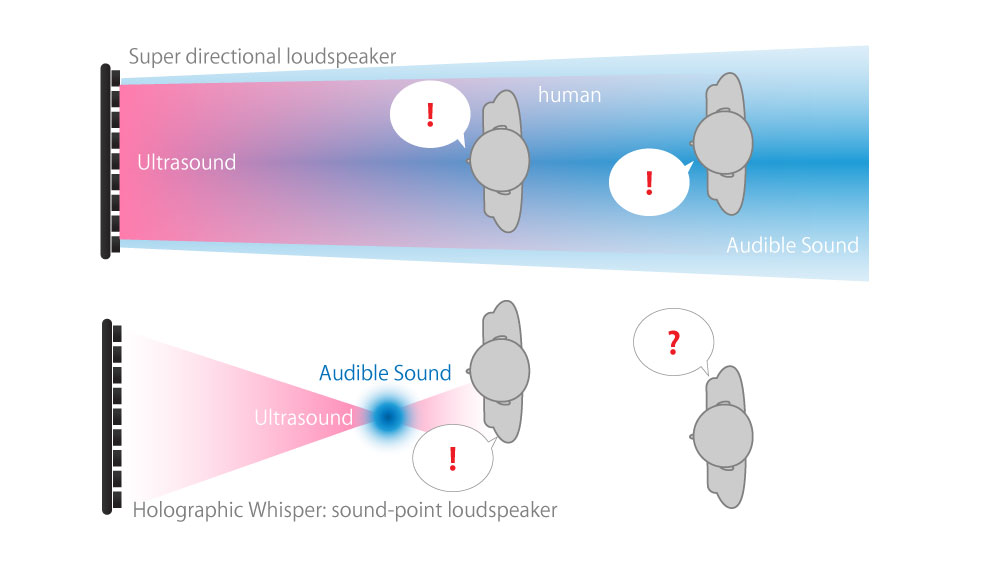
「Holographic Whisper」は、超⾳波の焦点をつくることで何もない空中から⾳を発⽣させる⾳響技術です。 ⾳の発⽣位置、再⽣する⾳声、ボリュームをうまく切り替えることで、誰に何をどこから聞かせるかを制御できます。
映像の中で注意を向けたい⽅向から⾳声を聞かせたり、イベント会場の特定の場所を通ったときのみ情報を届けたりと、視覚情報や位置情報と連動した没⼊感の⾼い演出が可能になります。また音量を絞ることによる特定の人物にだけ音声を届けることができます。これにより秘匿性の高い情報伝達や、周囲への音漏れに配慮したコミュニケーションなどが可能になります。さらに超音波焦点の位置を切り替えることにより、複数の人物にそれぞれ異なる音声を届けることもできます。
< Case >
■Case 1.
従来の超指向性スピーカーでは、直線上に⽴っている⼈間すべてに聞こえてしまう。⽅向だけでなく距離まで特定して、ギャラリーの展⽰品の⽬の前にいる⼈にだけ固有の情報を伝えたい。 また、席数が多いカフェスペースが混雑している際は呼び出し⾳が聞こえづらくなるので、特定の席・テーブルの周囲に座っているお客様にだけハッキリと聞こえるような⾳を出せないか。
■Case 2.
映像と連動した⾳響演出を⾏なう際、視聴者に⾳を聞かせる⽅向だけでなく、「近くで鳴っている」「遠くからぼんやり聞こえている」という⾵に、⾳源との距離感も変えることはできないか。
■Case 3.
タクシーなどの⼩型⾞両の運転⼿が業務連絡を⾏なう際、備え付けの無線が乗客にまで会話が聞こえてしまう。お客様に不快感を与えずにハッキリと通話ができる技術はないものか。 また⾃家⽤⾞に家族で乗る場合、運転席にはカーナビの⾳声、後部座席には⾳楽を流すなどという⾳環境の切り分けもできるのではないか。
< 原理 >
■⾮可聴⾳をキャリアとして、End to End で⾳を届ける
超⾳波は周波数が極めて⾼いため、⼈間の⽿では聞き取ることができません。しかし超⾳波の⾳圧が⼗分に⾼いとき、空気の⾮線形性によって超⾳波以外の周波数が⽣まれる現象が知られています。その応⽤として、超⾳波を可聴⾳で変調しておき、空気中で可聴⾳が放射されるようにする技術が研究されています。 この原理と超⾳波の分布を制御する技術を組み合わせることにより、私たちは、⾳声を特定の位置にのみ届けることを可能にしています。

■線ではなく点で⾳源を形成
私たちの技術では、複数並べた超⾳波振動⼦を適切な時間差で駆動させます。ひとつひとつの振動⼦が放射する超⾳波は弱いのですが、互いに⼲渉し、焦点を結んだときのみ可聴⾳を放射することのできる強度に達します。 ⾳源の位置を動かせるだけでなく、再⽣される可聴⾳のボリュームによって可聴範囲を拡⼤・縮⼩できるため、より細かいターゲッティングが可能になります。

■主な実績
[Award] 経済産業省 Innovative Technologies 2016 採択 (20/80) / 9 ⽉ 2 ⽇, 2016.
[Conference] CHI Conference - Denver, Colorado (USA), 5 ⽉ 6 - 11 ⽇, 2017.
[Exhibition] デジタルコンテンツ EXPO, ⽇本科学未来館, 10 ⽉ 28 ⽇, 2017.
[Exhibition] Image and Matter - Cyber Arts and Science Towards Digital Nature, Kuala Lumpur (Malaysia), 12 ⽉ 11 ⽇ - 1⽉ 14 ⽇, 2017.
[Exhibition] セミコンジャパン 2016, 東京ビッグサイト, 12 ⽉ 14-16 ⽇, 2016.
[Exhibition] デジタルコンテンツ EXPO, ⽇本科学未来館, 10 ⽉ 27-30 ⽇, 2016.
[Exhibition] ZOKEI NEXT 50 東京造形⼤学の教育成果展, ⻘⼭スパイラル, 10 ⽉ 25 ⽇ - 11 ⽉ 3 ⽇, 2016.
[Exhibition] Ars Electronica Festival 2016, Linz (Austria), 9 ⽉ 8 - 12 ⽇, 2016.
[Media] logmi, 2 ⽉ 10 ⽇, 2017.
[Media] ASCII 倶楽部, 9 ⽉ 27 ⽇, 2016.